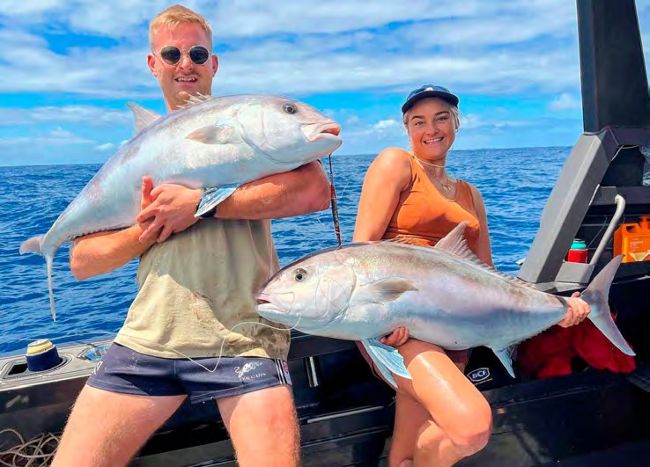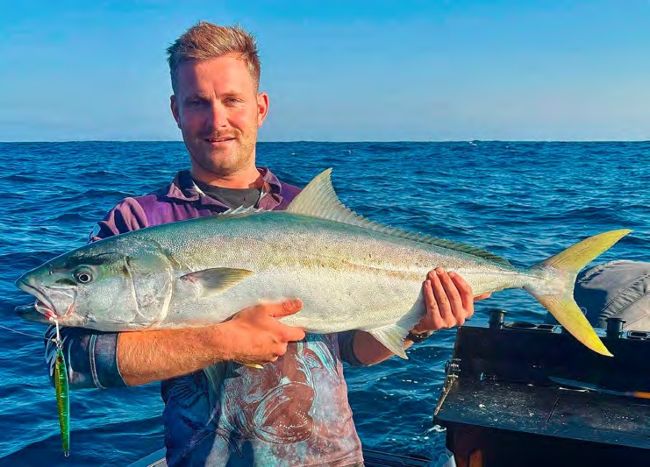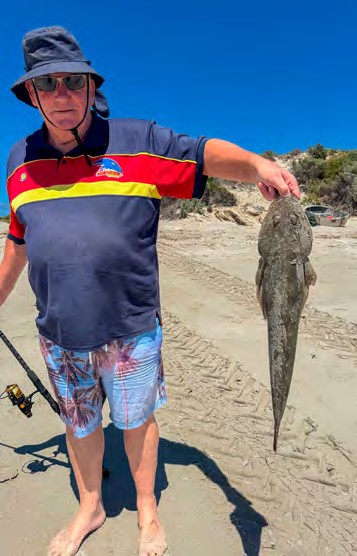SAMBOS AND KINGS AT WEDGE
Expat South Aussie, Charity Selleck, came home recently for a quick trip out to lock horns with some of our toughest sportfish.
On a muggy, hot summer morning I embarked on the long-awaited journey from my current hometown of Nhulunbuy, NT, to SA. The excitement was palpable, reuniting with mates who feel more like family, sharing laughs, and, of course, diving into an epic fishing adventure.
My trip started with a thrilling flight through a storm on a small plane from Nhulunbuy to Darwin, and then onto Adelaide.
Thankfully, sunny skies greeted me upon arrival. After touching down, there was no rush – just a few days over Christmas to catch up on a year’s worth of banter and stories I’d missed.
When it was time to hit the water, we packed up and drove from Adelaide to Port Victoria on the Yorke Peninsula. The crew launched the boat at Marion Bay while a few of us were treated to a luxur y ride in a four-seater plane directly to Wedge Island. Shortly after touching down on Wedge, we unloaded our gear at the house and prepared for several days of fishing. The anticipation in the air was electric amongst us all. The water off the island promised to be a playground for chasing sambos and kings – and we couldn’t wait to get started.
Five of us took to the water on day one, including the three brothers, Mat, Josh and Jase, our friend Kaleb (aka Kage), and myself. The weather promised good conditions for the next few days. Our first goal was to catch some samson fish.
Samson fish (or “sambos”) are powerful predators in the genus Seriola, growing up to 60cm in two years and potentially reaching 175cm over their 32-year lifespan. They feed on both pelagic and demersal prey. While not prized for taste, they are highly sought after by anglers for their fishing ability. A recent WA study found that, if handled with care, 93 per cent of released samson fish survive.
The SA samson fishery is largely seasonal, and during the summer months fish are typically seen in deeper water. Travelling from Wedge Island means that you can access some of these deeper lumps quicker. To find suitable locations, look for reef or structure that rises from 50-60m to about 40m from the surface. Start at the top of the structure and look for bait, or possibly samson fish, on the sounder on the reef’s edge.
Samson fish often sit a few metres above the sea floor and will likely stay around the same depth as one another. They tend to remain in front of the reef during a run in tide, known as a pressure edge. During the run out they will sit behind the reef, where bait often stacks up in the areas with less current.
GEAR TO USE FOR SAMBO’S AND KINGS
Dropping metal jigs and live baiting are the two preferred methods to entice these big fish. As big metal 150-300g jigs are used often, you must ensure that your tackle can handle it. A spin reel of 8000-12000 size paired with a PE5 rod is ideal. I would suggest investing in a specialised jigging rod, as it will mean you are able to work that heavy jig fast for longer periods before tiring. Pair this set up with 50-65lb braid and 100120lb leader. If you are specifically targeting the larger kings, you may want to opt for the tackle on the heavier side.

A pair of chunky samsons hooked south of Wedge
Long metal knife jigs are the most popular. If the drift speed is faster or the current stronger, it is best to drop a heavier jig, ensuring that the lure continues to work vertically during the retrieve. A 200g jig is a good starting point. There are various brands, and I have found that most of them work. The boys are currently trialling some local lures from JT Jigs and have had some success since this trip.
Depending on the brand of the jig, I would always recommend upgrading the hooks to Owner assist hooks in a size 8/0 or 9/0 to ensure those bigger fish stay hooked. Make sure to attach the jig to the leader via the solid ring at the lighter end of the jig. Some people run two hooks; however, I find it to be less likely to snag with the single hook at the top. Work the jig with a fast lift, then wind down to pick up the slack. You do not need to come all the way up to the top if the fish are sitting deep. During this trip we ran two types of live bait – one free swimming, and one with a sinker attached which we dropped closer to the bottom. Using a J or circle hook, rig the live bait through the shoulders, or top lip, of the fish. We used mainly circle hooks, making sure that the fish was completely hooked before picking up the rod. Trying to set the circle hook too early means you may lose fish. Any live bait should work, with slimy mackerel and squid being top tier.
LANDING THE FIRST SAMBO
After a short ride we reached the sambo lump, where we noticed two other boats – mates of the boys – already fishing. We wasted no time and prepared our gear. Jigs and live bait were all in play. With everything ready, we dropped our lines and started the day’s adventure. Sounding around, we found some bait and it wasn’t long before I landed my first fish of the day on a 200g knife jig. The fish took the jig about a quarter of the way up in the water column and was a fat 125cm specimen to start the day. It was an exciting moment to get the ball rolling. Shortly after a slight change of location on the lump, the sounder lit up, confirming what we all knew – there were sambos around, and plenty of them.
For the next two hours we hooked several sambos, each one as chunky as the last. The total haul by the end of the first mark was an impressive six between us all. And now was the time, to chase the almighty kingfish.
Like the samson, the kingfish is of the Seriola genus. Both are fish that can be caught while targeting each other. Kingfish are drawn to structure and can often bust you off on said structure, and this is when the intense fight begins. The kingfish rivals the samson in size, possibly reaching maximum lengths of 2.5m and weighing up to 70kg. They are one of the hardest and most unforgiving fighting fish during a battle. Even with the right gear and experience, be prepared to lose a few of the larger models.
Reaching the kingfish spot, I landed one early on the jig. However, the real excitement came when Jason launched his drone into the air for look around. At first we thought we were seeing tuna near the surface in 40-50m of water, but to our surprise, it was a school of kings!
We raced over to where the commotion was and witnessed a large school of kingfish ferociously smashing bait near the surface. The scene was pure chaos, with the water erupting as the kings aggressively attacked the bait. We all stood in awe, watching as flashes of silver and yellow streaked through the water. It was a sight that left us stunned; the sheer size, power and speed of kingfish are undeniable. Everyone raced around the boat, and within seconds we had the jigs and live baits ready to go.

Kings love JT's jigs!

A big school of kings on the surface, and ready to pounce!
It was then that an undeniable urge took over me. Having spent the past year and a half top-water fishing in the North, I couldn’t resist the temptation to throw out a surface lure. I mean, what were the chances of ever having this opportunity again? I cast a shallow-diving stick bait about 30m from the boat towards the fish and, to my delight, there were two immediate follows from large fish. I couldn’t help but yell, “Did you see the size of those?” while, I made eye contact with my mate Kage, who laughed in disbelief.
On the third cast two kingfish charged the lure, and one of them smashed it with incredible force right on the surface. “TOP WATER KINGY!” I shouted repetitively, as the fully locked reel began to scream, and the adrenaline took over my body. I was ecstatic, and in complete shock at the fact that I’d just witnessed a kingy hit my lure on the surface from the deep blue. As I fought the fish, two more rods went off, and soon enough we were all boating kings. Mine was a skinny, long fish at 112cm, but the others weren’t far behind at around the 100-110cm mark. By the end of the day we had landed six kings, with a near perfect ratio of jigs to live bait.
Next morning the sound of the tractor pulling the boat down the beach signalled the beginning of our second day of fishing. It started early, with a return to the Sambo lump. Tom, a friend from Germany, was with us, and we spent a good while discussing how to catch a kingfish on the trip out. The biggest fish he had ever caught was the legendary King George whiting, so this was all new territory.
Word must have spread, as we found ourselves surrounded by several boats at the first mark. The fish were harder to come by, and we were all a bit impatient at the thought of reaching the kingfish mark again. After not being there long, we were once again heading to the hot spot.
The commotion had died down from the day before. However, the sounder revealed the fish were still there, just down deeper, and with my first drop of the jig I landed a kingy. Shortly afterwards, Tom had his first run in with a kingy, where he was taken to the reef and busted off. He sat down puffing and defeated, yet out to seek vengeance.
As the day progressed, captain Mat found the perfect drift and we started a consistent pattern of hooking up on live bait. Each of us took turns, and our tally continued to rise, losing some big fish in the process. Tom managing to land his later that day. We managed 12 kingfish in total for the day, all but one caught on live bait.
HOME TIME
Next morning some of the boys headed out again, landing even more impressive fish. As for me, I spent the day filleting yesterday’s kept fish, and fished off the shore for flathead. In just two hours I managed to land 15, with the largest measuring 55cm. My mate’s dad (Johhny) was the star of the show, pulling in two flathead – one in the low 60s and the other in the high 60s. He certainly outshone me with the quality of his catch!
That evening we filled our bellies with fresh fish and retold fishing stories. As the sun set, I relaxed with a piña colada in hand, feeling incredibly grateful for the holiday spent with great friends, and unforgettable fishing. Every muscle ached from the non-stop action, acting as a reminder of just how hard that trip would be to top.

Wedge has some lovely flathead
In honesty, the boys back home have really honed their skills. Without their local knowledge and secret fishing spots, I may never have had the chance to land a top-water kingfish, about which I can taunt the boys about for years to come. Thanks always, Jackknife Adventures crew, until next time!
SOCIAL MEDIA INSTAGRAM LINKS:
@charity_selleck
@jackknife_adventures